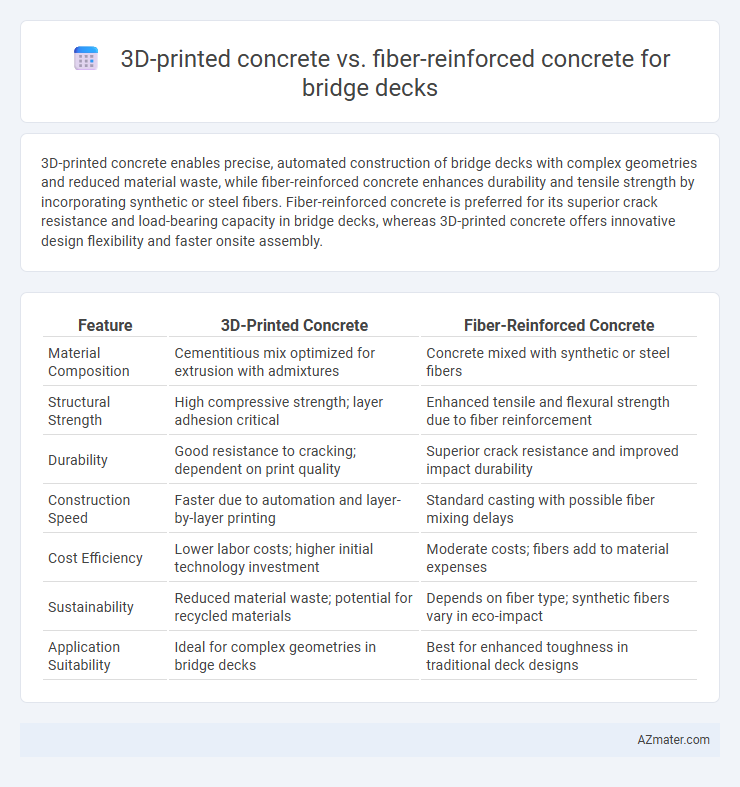3D-printed concrete enables precise, automated construction of bridge decks with complex geometries and reduced material waste, while fiber-reinforced concrete enhances durability and tensile strength by incorporating synthetic or steel fibers. Fiber-reinforced concrete is preferred for its superior crack resistance and load-bearing capacity in bridge decks, whereas 3D-printed concrete offers innovative design flexibility and faster onsite assembly.
Table of Comparison
| Feature | 3D-Printed Concrete | Fiber-Reinforced Concrete |
|---|---|---|
| Material Composition | Cementitious mix optimized for extrusion with admixtures | Concrete mixed with synthetic or steel fibers |
| Structural Strength | High compressive strength; layer adhesion critical | Enhanced tensile and flexural strength due to fiber reinforcement |
| Durability | Good resistance to cracking; dependent on print quality | Superior crack resistance and improved impact durability |
| Construction Speed | Faster due to automation and layer-by-layer printing | Standard casting with possible fiber mixing delays |
| Cost Efficiency | Lower labor costs; higher initial technology investment | Moderate costs; fibers add to material expenses |
| Sustainability | Reduced material waste; potential for recycled materials | Depends on fiber type; synthetic fibers vary in eco-impact |
| Application Suitability | Ideal for complex geometries in bridge decks | Best for enhanced toughness in traditional deck designs |
Introduction: Overview of Modern Bridge Deck Materials
3D-printed concrete offers precise material placement and design flexibility, enabling efficient construction of complex bridge deck geometries with reduced labor costs and construction time. Fiber-reinforced concrete enhances tensile strength and durability by integrating synthetic or steel fibers, improving crack resistance critical for bridge deck longevity under dynamic loads. Both materials represent advancements over traditional concrete, aiming to optimize structural performance, sustainability, and maintenance in modern bridge deck applications.
What is 3D-Printed Concrete Technology?
3D-printed concrete technology involves layering concrete material through automated additive manufacturing processes to create complex, customized bridge deck components with reduced waste and enhanced design flexibility. Unlike traditional fiber-reinforced concrete, which relies on mixed-in fibers for tensile strength, 3D-printed concrete allows precise control over material placement and structural optimization at a micro-level. This innovative approach improves construction speed, reduces labor costs, and enables strength tailoring for bridge decks, aligning with sustainable infrastructure goals.
Fiber-Reinforced Concrete: Composition and Advantages
Fiber-reinforced concrete for bridge decks incorporates materials such as steel, glass, or synthetic fibers, enhancing tensile strength and crack resistance compared to traditional concrete. The composite material improves durability and reduces maintenance costs by mitigating fatigue and impact damage in bridge structures. Its superior load-bearing capacity and resistance to environmental stressors make fiber-reinforced concrete a reliable choice for long-lasting, sustainable bridge deck construction.
Structural Performance Comparison
3D-printed concrete offers precise layer control and complex geometries, enhancing load distribution in bridge decks, while fiber-reinforced concrete (FRC) provides superior tensile strength and crack resistance due to embedded fibers. Studies reveal that FRC exhibits higher toughness and ductility under cyclic loading, crucial for dynamic bridge deck performance, whereas 3D-printed concrete demonstrates potential in optimizing material usage and reducing construction time. The structural performance of bridge decks benefits from FRC's improved durability and post-crack load capacity, though 3D printing innovations may soon bridge the gap by integrating fiber reinforcement techniques.
Durability and Longevity Analysis
3D-printed concrete offers precise layer deposition, reducing voids and enhancing durability through uniform material distribution, which benefits bridge deck longevity. Fiber-reinforced concrete incorporates synthetic or steel fibers that significantly improve tensile strength and crack resistance, leading to enhanced durability under dynamic loads experienced in bridge decks. Comparative analyses show fiber-reinforced concrete excels in fatigue resistance, while 3D-printed concrete's automated layering promises consistent structural integrity, both crucial for sustainable bridge deck performance.
Speed of Construction and On-Site Efficiency
3D-printed concrete enables faster construction of bridge decks by automating layer deposition, significantly reducing labor and formwork requirements compared to traditional methods. Fiber-reinforced concrete enhances on-site efficiency through improved material durability and reduced cracking, which minimizes repair time during curing. Combining 3D printing technology with fiber reinforcement further accelerates construction timelines and optimizes structural performance.
Cost Analysis: Material and Labor Considerations
3D-printed concrete for bridge decks reduces labor costs significantly by automating the construction process, while fiber-reinforced concrete incurs higher labor expenses due to traditional casting and curing methods. Material costs for 3D-printed concrete can be lower as it uses precise amounts of specialized cementitious mixes, whereas fiber-reinforced concrete requires additional fibers, increasing raw material expenses. Overall, 3D printing offers cost savings through enhanced efficiency and reduced waste, contrasting with the higher material and labor demands of fiber-reinforced concrete.
Environmental Impact and Sustainability
3D-printed concrete reduces material waste by precisely dispensing concrete only where needed, significantly lowering carbon emissions associated with overproduction compared to traditional methods. Fiber-reinforced concrete enhances durability and reduces maintenance frequency for bridge decks, contributing to prolonged service life and resource efficiency. Both technologies improve sustainability, but 3D printing offers greater potential for customization and minimal environmental footprint through optimized material usage.
Challenges and Limitations of Each Method
3D-printed concrete for bridge decks faces challenges such as limited material strength and potential layer adhesion issues, compromising structural integrity under heavy loads. Fiber-reinforced concrete offers enhanced tensile strength and crack resistance but encounters limitations in uniform fiber distribution and increased material costs. Both methods require careful quality control and optimization to address scalability and long-term durability in bridge applications.
Future Trends and Innovations in Bridge Deck Construction
3D-printed concrete revolutionizes bridge deck construction by enabling complex geometries and rapid, onsite fabrication, reducing material waste and labor costs. Fiber-reinforced concrete offers enhanced tensile strength and durability, significantly improving load-bearing capacity and resistance to cracking in bridge decks. Future trends emphasize hybrid approaches combining 3D printing with fiber reinforcement, integrating smart sensors for real-time structural health monitoring and sustainable material formulations to extend service life and reduce environmental impact.

Infographic: 3D-printed concrete vs Fiber-reinforced concrete for Bridge deck
 azmater.com
azmater.com